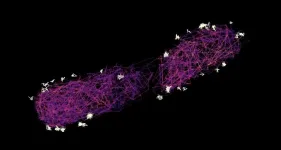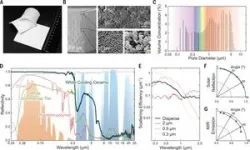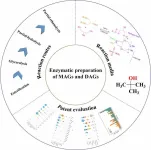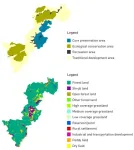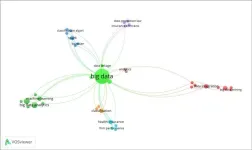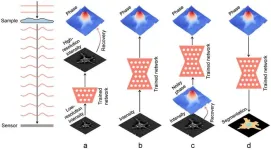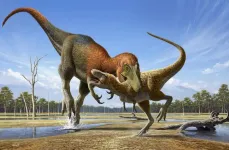(Press-News.org) Disease-causing bacteria of the genus Salmonella or Yersinia can use tiny injection apparatuses to inject harmful proteins into host cells, much to the discomfort of the infected person. However, it is not only with a view to controlling disease that researchers are investigating the injection mechanism of these so-called type III secretion systems, also known as "injectisomes".
If the structure and function of the injectisome were fully understood, researchers would be able to hijack it to deliver specific drugs into cells, such as cancer cells. In fact, the structure of the injectisome has already been elucidated. However, it remained unclear how the bacteria load their syringes so that the right proteins are injected at the right time.
Mobile components of the injectisome search for proteins
A team of scientists led by Andreas Diepold from the Max Planck Institute for Terrestrial Microbiology in Marburg and Ulrike Endesfelder from the University of Bonn has now been able to answer this question: mobile components of the injectisome comb through the bacterial cell in search of the proteins to be injected, so-called effectors. When they encounter an effector, they transport it like a shuttle bus to the gate of the injection needle.
"How proteins of the sorting platform in the cytosol bind to effectors and deliver the cargo to the export gate of the membrane-bound injectisome is comparable to the processes at a freight terminal", explains Stephan Wimmi, first author of the study as a postdoctoral researcher in Andreas Diepold's laboratory. "We think that this shuttle mechanism helps to make the injection efficient and specific at the same time - after all, the bacteria have to inject the right proteins quickly to avoid being recognized and eliminated by the immune system, for example."
To gain this insight into the important loading mechanism of the injectisome, the researchers had to apply new techniques. "Conventional methods, which are normally used to detect that proteins bind to each other, did not work to answer this question - possibly because the effectors are only bound for a short time and then immediately injected," explains Andreas Diepold, research group leader at the Max Planck Institute and co-leader of the study. "That's why we had to analyse this binding in situ in the living bacteria.”
“To measure these transient interactions we made use of two novel approaches that work in living cells, proximity labeling and single-particle tracking,” adds Ulrike Endesfelder, whose group worked on the study in three different locations – the Max Planck Institute in Marburg, Carnogie Mellon University in Pittsburgh, PA, USA, and at the University in Bonn. Proximity labeling, in which a protein marks its immediate neighbors like a paintbrush, enabled them to show that the effectors in the bacterium bind to the mobile injectisome components. This binding was examined in more detail using single particle tracking, a high-resolution microscopy method that can follow individual proteins in cells. These methods, which the team refers to as "in situ biochemistry", i.e. biochemical investigations on site, made the breakthrough possible.
The researchers next want to use their method to investigate other mechanisms that bacteria use to cause infections. "The more we know about how bacteria use these systems during an infection, the better we can understand how we can influence them - be it to prevent infections or to modify the systems in order to use them in the fields of medicine or biotechnology,” says Andreas Diepold.
END
Bacteria load their syringes
Pathogenic bacteria use molecular "shuttle services" to fill their injection apparatus with the right product
2024-01-03
ELSE PRESS RELEASES FROM THIS DATE:
Greener and feasible production: Enzymatic methods for mono- and diacylglycerol synthesis in the food industry
2024-01-03
MAGs, predominantly in 1(3)-MAG form, and DAGs, with 1,3-DAGs as the more stable isomer, are crucial in food, cosmetic, and other industries. While MAGs are vital emulsifiers, comprising 75% of global production, DAGs are known as functional cooking oils that can reduce body fat and serum TAGs. However, their natural concentration in oils is low, prompting extensive research into their chemical and environmentally-friendly enzymatic production.
Recently, a review published in the Grain & Oil Science and Technology journal on 2 November 2023, has shed light on the advancements in enzymatic production methods with special efforts on practical and ...
Re-calibrating the sail plan for Native Hawaiians, Pacific Islanders in ocean sciences
2024-01-03
In Hawaiʻi and across much of Oceania, Pacific Islanders celebrate the connections between their islands and the ocean that surrounds them. “As descendants of the ocean, the dearth of Native Hawaiians and Pacific Islanders (NHPI) in ocean science seems inconsonant,” writes a team of authors that includes University of Hawai‘i (UH) at Mānoa faculty, students, and alumni in an article in a special issue of the journal Oceanography, “Building Diversity, Equity, and Inclusion in the Ocean Sciences. The authors ask, “Where are all our island people in the ...
Monetized evaluation of landscape resources of national parks based on the willingness to pay of multiple interest groups
2024-01-03
In China, national parks represent the country’s most unique natural landscapes. Scientific evaluation of landscape resources is significant for preserving the authenticity and integrity of national parks. Taking Qianjiangyuan National Park System Pilot Zone as an example, this research investigated the willingness of internal group (residents and administrative staff) and external group (tourists) to pay for a hypothetical market project based on the pilot zone via Contingent Valuation Method to acquire the monetized value of landscape resources in the national park, and applied Logistic Regression to analyze the influencing factors. The results show ...
How big data transforms the insurance sector
2024-01-03
In 2022, the insurance industry made a whopping USD 6 trillion globally—more than the entire economy of big countries like Japan and Germany. A new study, published in The Journal of Finance and Data Science, looked at how technology, especially big data, is shaking things up in insurance. Big data means using a lot of information to make better decisions.
The study found that by using big data, insurance companies can understand risks better, offer fair prices and keep customers happier.
“What's surprising is how fast insurance companies are jumping on the big data bandwagon,” says first ...
Deep learning for phase recovery
2024-01-03
Light, as an electromagnetic field, has two essential components: amplitude and phase. However, optical detectors, usually relying on photon-to-electron conversion (such as charge-coupled device sensors and the human eye), cannot capture the phase of the light field because of their limited sampling frequency. Fortunately, as the light field propagates, the phase delay also causes changes in the amplitude distribution; therefore, we can record the amplitude of the propagated light field and then calculate the corresponding phase, called phase recovery. Some common phase ...
Chicken whisperers: humans crack the clucking code
2024-01-03
A University of Queensland-led study has found humans can tell if chickens are excited or displeased, just by the sound of their clucks.
Professor Joerg Henning from UQ’s School of Veterinary Science said researchers investigated whether humans could correctly identify the context of calls or clucking sounds made by domestic chickens, the most commonly farmed species in the world.
“In this study, we used recordings of chickens vocalising in all different scenarios from a previous experiment,” ...
Newly discovered genetic mutation protects against Parkinson’s disease and offers hope for new therapies
2024-01-03
A previously unidentified genetic mutation in a small protein provides significant protection against Parkinson’s disease and offers a new direction for exploring potential treatments, according to a new USC Leonard Davis School of Gerontology study.
The variant, located in a mitochondrial microprotein dubbed SHLP2, was found to be highly protective against Parkinson’s disease; individuals with this mutation are half as likely to develop the disease as those who do not carry it. The variant form of the protein is relatively rare and is found primarily in people of European descent.
The findings appear on January 3, 2024, in the journal Molecular Psychiatry.
First ...
First dive survey of Lake Tahoe’s lakebed finds high amounts of plastic and other litter
2024-01-03
Plastic litter is a growing problem around the world, and new research shows that the bottom of Lake Tahoe is no exception. In one of the first studies to utilize scuba divers to collect litter from a lakebed, 673 plastic items were counted from just a small fraction of the lake.
In the study, published in the November issue of the journal Applied Spectroscopy, researchers from DRI and the UC Davis Tahoe Environmental Research Center teamed up with the nonprofit Clean Up the Lake to take a close look at the litter. First, ...
Study on extremely preterm infants provides important healthcare knowledge
2024-01-03
Infants born extremely prematurely need to get enrichment as an addition to breast milk. But does it make any difference whether the enrichment is made from breast milk or cow’s milk when it comes to the risk of severe complications in children? This has been investigated by a large clinical study led from Linköping, Sweden.
Infants born extremely prematurely, between weeks 22 and 27 of pregnancy, are among the most vulnerable patients in healthcare. The risk of serious complications is very high. Almost one in four extremely premature babies die before the age of one.
There is strong research support for giving breast ...
New research shows “Juvenile T. rex” fossils are a distinct species of small tyrannosaur
2024-01-03
A new analysis of fossils believed to be juveniles of T. rex now shows they were adults of a small tyrannosaur, with narrower jaws, longer legs, and bigger arms than T. rex. The species, Nanotyrannus lancensis, was first named decades ago but later reinterpreted as a young T. rex.
The first skull of Nanotyrannus was found in Montana in 1942, but for decades, paleontologists have gone back and forth on whether it was a separate species, or simply a juvenile of the much larger T. rex.
Dr Nick Longrich, from the Milner Centre for Evolution at the University ...
LAST 30 PRESS RELEASES:
SIMJ announces global collaborative book project in commemoration of its 75th anniversary
Air pollution exposure and birth weight
Obstructive sleep apnea risk and mental health conditions among older adults
How talking slows eye movements behind the wheel
The Ceramic Society of Japan’s Oxoate Ceramics Research Association launches new international book project
Heart-brain connection: international study reveals the role of the vagus nerve in keeping the heart young
Researchers identify Rb1 as a predictive biomarker for a new therapeutic strategy in some breast cancers
Survey reveals ethical gaps slowing AI adoption in pediatric surgery
Stimulant ADHD medications work differently than thought
AI overestimates how smart people are, according to HSE economists
HSE researchers create genome-wide map of quadruplexes
Scientists boost cell "powerhouses" to burn more calories
Automatic label checking: The missing step in making reliable medical AI
Low daily alcohol intake linked to 50% heightened mouth cancer risk in India
American Meteorological Society announces Rick Spinrad as 2026 President-Elect
Biomass-based carbon capture spotlighted in newly released global climate webinar recording
Illuminating invisible nano pollutants: advanced bioimaging tracks the full journey of emerging nanoscale contaminants in living systems
How does age affect recovery from spinal cord injury?
Novel AI tool offers prognosis for patients with head and neck cancer
Fathers’ microplastic exposure tied to their children’s metabolic problems
Research validates laboratory model for studying high-grade serous ovarian cancer
SIR 2026 delivers transformative breakthroughs in minimally invasive medicine to improve patient care
Stem Cell Reports most downloaded papers of 2025 highlight the breadth and impact of stem cell research
Oxford-led study estimates NHS spends around 3% of its primary and secondary care budget on the health impacts of heat and cold in England
A researcher’s long quest leads to a smart composite breakthrough
Urban wild bees act as “microbial sensors” of city health.
New study finds where you live affects recovery after a hip fracture
Forecasting the impact of fully automated vehicle adoption on US road traffic injuries
Alcohol-related hospitalizations from 2016 to 2022
Semaglutide and hospitalizations in patients with obesity and established cardiovascular disease
[Press-News.org] Bacteria load their syringesPathogenic bacteria use molecular "shuttle services" to fill their injection apparatus with the right product
